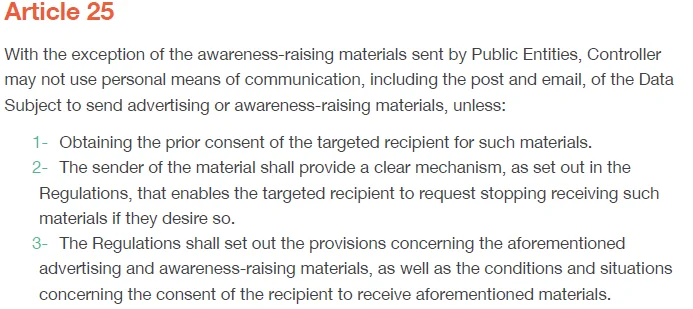
Abstract Of KSA PDPL – Article 25
This research focuses on Article 25 of the Kingdom of Saudi Arabia’s Personal Data Protection Law (KSA PDPL), which governs the use of personal means of communication, including email and post, for sending advertising and awareness materials. The paper emphasizes the requirements for obtaining consent from recipients and presents strategic considerations for organizations that aim to comply with these provisions. The study also examines key implementation challenges and technological solutions to manage communications while protecting the privacy rights of data subjects.
Key Words
KSA PDPL; Article 25; Personal Data Protection; Consent Management; Advertising Compliance; Communication Control; Data Subject Rights; Saudi Arabia; Email Marketing
Introduction Of KSA PDPL – Article 25
The Kingdom of Saudi Arabia’s Personal Data Protection Law (PDPL) establishes the legal framework for data protection and privacy rights in the Kingdom. Article 25 specifically addresses how organizations (Controllers) may utilize personal means of communication, such as email and post, to send advertising and awareness materials. This article mandates prior consent from data subjects before such communication and provides mechanisms for data subjects to opt out of future communications. This paper explores the implications of Article 25 and provides guidance on how organizations can ensure compliance.
Explanation Of KSA PDPL – Article 25
Article 25 prohibits Controllers from using personal means of communication to send advertising or awareness materials unless they have obtained the explicit prior consent of the targeted recipient. Furthermore, organizations must offer a clear, accessible way for recipients to opt out of receiving future communications. Public entities are exempt from this provision when sending awareness-raising materials.
Key Strategic Points
- Consent Management: Organizations must implement mechanisms to obtain explicit, informed consent from data subjects before sending any marketing communications.
- Opt-out Mechanism: There must be a clear, simple process for recipients to withdraw consent or request end/termination of communications.
- Regulatory Alignment: Controllers should ensure that their practices align with the regulations set out by the Saudi Data and Artificial Intelligence Authority (SDAIA) regarding consent and communication control.
General Activation Steps
- Develop consent management policies and integrate them into organizational processes.
- Implement opt-out mechanisms in all communications, ensuring they are clearly visible and user-friendly.
- Educate marketing and communication teams on legal requirements.
- Regularly review and update practices to remain compliant with any updates to the Regulations.
Enablement Methodology
- Data Collection: Ensure that all data collected for communication purposes includes explicit consent records.
- Technology Integration: Utilize consent management platforms (CMPs) to automate consent tracking and provide opt-out functionality.
- Training: Provide periodic training to staff on the importance of data subject rights and compliance with Article 25.
Use Cases
- Marketing Campaigns: Before sending email or postal advertisements, obtain prior consent and ensure opt-out mechanisms are in place.
- Awareness Campaigns by Public Entities: Public entities can send awareness materials without prior consent but must follow regulations concerning such communications.
Dependencies
- Legal Counsel: Ensure ongoing legal guidance to interpret and apply Article 25 accurately.
- Technological Infrastructure: Implement tools that can support consent management and opt-out functionality.
Tools/Technologies
- Consent Management Platforms (CMP): Tools such as OneTrust or TrustArc can help automate the process of managing consent and preferences.
- Email Marketing Solutions: Platforms like Mailchimp or HubSpot can help integrate opt-out mechanisms into marketing communications.
Challenges & Risks Of KSA PDPL – Article 25
- Consent Fatigue: Repeated requests for consent may lead to lower response rates and disengagement.
- Regulatory Misinterpretation: Misunderstanding the legal requirements could result in non-compliance, leading to potential fines or penalties.
- Technological Complexity: Implementing advanced consent management systems may require significant technical expertise and investment.
Conclusion
Article 25 of the KSA PDPL presents clear guidelines for using personal communication methods for marketing and awareness-raising purposes. Organizations must prioritize consent management and ensure that they have robust opt-out mechanisms in place. By adhering to the requirements set forth by the law and leveraging appropriate technological tools, Controllers can maintain compliance while promoting trust with data subjects.
References
- Kingdom of Saudi Arabia Personal Data Protection Law, Article 25.
- Saudi Data and Artificial Intelligence Authority (SDAIA) Regulations on Personal Data Protection.
- Consent Management Solutions: OneTrust, TrustArc, Mailchimp, HubSpot.
Recommended Resources:
- Big Data vs. Traditional Data, Data Warehousing, AI, and Beyond
- Big Data Security, Privacy, and Protection, & Addressing the Challenges of Big Data
- Designing Big Data Infrastructure and Modeling
- Leveraging Big Data through NoSQL Databases
- Data Strategy vs. Data Platform Strategy
- ABAC – Attribute-Based Access Control
- Consequences of Personal Data Breaches
- KSA PDPL (Personal Data Protection Law) – Initial Framework
- KSA PDPL – Consent Not Mandatory
- KSA PDPL Article 4, 5, 6, 7, 8, 9, 10, 11, & 12
- KSA PDPL Article 13, 14, 15, 16, 17, 18, 19, 20, 21, 22, 23, & 24
- KSA NDMO – Data Catalog and Metadata
- KSA NDMO – Personal Data Protection – Initial Assessment
- KSA NDMO – DG Artifacts Control – Data Management Issue Tracking Register
- KSA NDMO – Personal Data Protection – PDP Plan, & PDP Training, Data Breach Notification
- KSA NDMO – Classification Process, Data Breach Management, & Data Subject Rights
- KSA NDMO – Privacy Notice and Consent Management
- Enterprise Architecture Governance & TOGAF – Components
- Enterprise Architecture & Architecture Framework
- TOGAF – ADM (Architecture Development Method) vs. Enterprise Continuum
- TOGAF – Architecture Content Framework
- TOGAF – ADM Features & Phases
- Data Security Standards
- Data Steward – Stewardship Activities
- Data Modeling – Metrics and Checklist
- How to Measure the Value of Data
- What is Content and Content Management?

